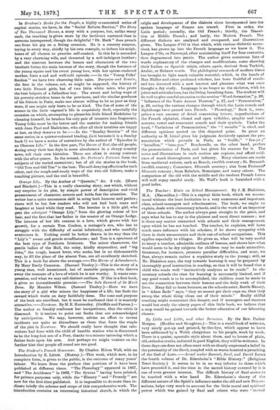The Student's French Grammar. By Charles 114ron Wall, with an
Introduction by E. LittrtS. (Murray.)—This work, which now, in its complete form, is given to the public, is the outcome of many years' labour. We learn from the preface that portions of it have been published at different times. "The Phonology" appeared in 1867, and " The Accidence " in 1869, " The Syntax " having been printed, for private purposes only, while the "History" and " Prosody " are now for the first time published. It is impossible to do more than in- dicate briefly the scheme and scope of this comprehensive work. The introduction contains an interesting historical sketch, in which the origin and development of the dialects since incorporated into the spoken language of France are traced. First in order, the Latin period ; secondly, the Old French; thirdly, the Transi- tion or Middle French; and lastly, the Modern French. The different dialects are analysed and compared, and illustrations given. The League d'Oil is that which, with various dialectic accre- tions, has grown up into the French language as we know it. The Lenore d'Oc, or Provencal, after maintaining itself for four centuries, then degenerated into patois. The author gives numerous lists of words explanatory of the changes and modifications, some showing their Italian or Spanish origin, others, again, derived from Turkish, Arabic, or Hebrew words. The philological research of modern times has brought to light much valuable material, which, in the hands of Max Muller and other profound scholars, has been fruitful of result, and has invested with a new interest and pleasure what was once thought a dry study. Language is no longer as the skeleton, with its joints and articulations, but the living, breathing form. The student will do well to give careful attention to the section " Word-formation," p. 26, `` Influence of the Tonic Accent Thereon," p. 27, and " Permutation," p. 28, noting the various changes through which the Latin vowels and diphthongs have passed into French. " Phonology," Book ii., com- prises a vast amount of detail concerning letters, imperfections of the French alphabet, closed and open syllables, graphic and tonic accents, vowel and consonant sounds and their symbols. Under the bead, " Variations of Pronunciation," the " / mouille " is cited, and different opinions quoted on this disputed point. So great an authority as M. Littre' gives his judgment decisively against the pro- nunciation which prevails in Paris, as " " fen-ye ;'' " bataillon," "bats-yon." Bescberelle, on the other hand, prefers the pronunciation of Paris, and has given his reasons for it The notes and illustrations in each section are copious, and afford evid- ence of much thoroughness and industry. Many citations are made from mediteval writers, such as Benoit, twelfth century ; St. Bernard, twelfth century ; Commines, fifteenth century ; also from Froissarti fifteenth century ; from Rabelais, Montaigne, and many others. The comparison of the old with the middle and the modern French forms will well repay careful study. Mr. Wall's book is furnished with a good index.


































 Previous page
Previous page